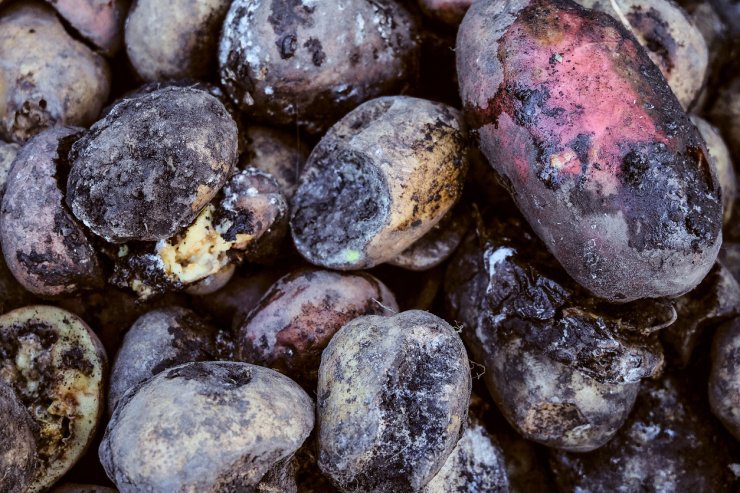
Diseased, rotted potatoes
The best way to prevent potato diseases is to avoid creating conditions to let infections in. It really begins with getting certified seed potatoes, then monitoring your plants for signs of disease, and maintaining good soil moisture.
Any plants that have yellow or shriveled leaves before the end of the season, appear smaller than the others, or just look different should be removed and discarded. Always discard diseased plants in the trash, not the compost.
These are the common diseases in potatoes and how to address them.
Common Potato Diseases
Common Scab
Common scab is a cosmetic disease; it doesn’t affect the quality of the potato. However, it does mean you’ll need to have your paring knife ready to cut those pieces away. You won’t see this until harvest, of course.
Cause: Bacteria Streptomyces scabies
Symptoms:
- Small brown lesions on the potato skin
How it spreads:
- Overwinters in soil
- Surface of seed potatoes
- Crop residues
Treatment:
- Use a paring knife and cut the lesions away
Prevention:
- Crop rotation
Early Blight
Primarily affects foliage, but left untreated can affect the tubers. Note: Potatoes whose leaves have been stricken by early blight are still edible.
Cause: Fungus Alternaria solani
Symptoms:
- Lesions that look like targets, starting on the lower, maturing leaves of the plant
How it spreads:
- Spores fall on potato leaves, wait to germinate, and attack until the plant is weak, generally toward the end of the season
Treatment:
- Fungicide can help treat this
Prevention:
- Prevent plant stress
- Maintain proper water and fertilizer levels
Late Blight
Late blight is a death knell for potatoes. The tubers become discolored and break down. You must discard diseased plants immediately.
Cause: Fungus
Symptoms:
- Dark, greasy-looking lesions on the leaves
- Upper leaves may have a yellow “halo” around the lesions
- Underside of the leaves may have lesions ringed with white fungus
How it spreads:
- Fungal infection that can be spread by the wind to other areas of your garden—or your neighbor’s garden
- Spores can travel for miles and affect commercial production miles away so it’s essential to monitor the health of your plants
Treatment:
- Preventive fungicide is the only option
- Once late blight afflicts a plant, remove it and discard it in the trash—never in the compost
Prevention:
- Consider planting potatoes with some resistance to late blight, such as Kennebec
Pink Rot
Commonly called water rot (killed with kindness?), pink rot is the result of overwatering.
Cause: Fungus Phytophthora erythroseptica
Symptoms:
- Swollen, waterlogged tubers, partially or completely rotted
- If cut or broken open, they turn salmon pink within a half hour
How it spreads:
- Will spread with tubers close-by
- Enters tubers through the stem of the tuber and through lesions
Treatment:
- Water management, especially late in the growing season
Prevention:
- Don’t overwater potatoes
Black Scurf
As creepy as it sounds, black scurf is a strictly cosmetic disease. But it’s probably worth getting disease-free seed to avoid it.
Cause: Fungus Rhizoctonia solani
Symptoms:
- Small, irregular black patches on the potato skin that won’t wash off
How it spreads:
- In the soil
Treatment:
- Biological fungicide Trichoderma harzianum
Prevention:
- Buy certified disease-free seed
Common Sweet Potato Diseases
Sweet potatoes tend to be less susceptible to disease than their [not really] cousins, the potato. There are enough ailments for sweet potatoes to fill a small book, but these tubers usually tend to be fairly tough—as long as you take care of them.
Bacterial Stem and Root Rot
Cause: Bacteria
Symptoms:
- Dark lesions on the stems and petioles (the stem that supports the leaf)
- Wilted plants
- Lesions on the root or rot inside the root
How it spreads:
- Soil-borne disease that can lie dormant in the soil for years
Treatment:
- Destroy diseased plants
Prevention:
- Buy certified disease-free plants/slips
- Rotate crops regularly
- Before planting, turn soil over and allow it to dry; repeat
- Cover soil with black plastic to heat up the soil
Bacterial Wilt
Cause: Bacteria
Symptoms:
- Wilted plants
- Yellow to brown lesions at the base of the plant stem
- Harvested roots may have brown streaks or develop a distinctive odor
How it spreads:
- Soil-borne disease that can lie dormant in the soil for years
Treatment:
- Destroy diseased plants
Prevention:
- Buy certified disease-free plants/slips
- Rotate crops regularly
- Before planting, turn soil over and allow it to dry; repeat
- Cover soil with black plastic to heat up the soil
Leaf Spot
Leaf spot is very common around the world. It doesn’t affect the root, but it can damage the leaves and vines of the plant.
Cause: Fungus
Symptoms:
- Whitish, tan, or brown lesions on the upper and lower surfaces of the leaves
- The lesions usually have a dark brown or purple edge
How it spreads:
Treatment:
- None known
- Destroy and discard damaged plant material
Prevention:
- Buy certified disease-free plants/slips
- Rotate crops regularly
- Apply fungicides
Fusarium Wilt
This is a soil-borne fungus that specifically targets sweet potatoes.
Cause: Fungus
Symptoms:
- Dull, yellowing leaves
- Wilting vine
How it spreads:
- Can survive in the soil—and in the affected plant matter—for years
Treatment:
- Buy disease-resistant slips
- Destroy and discard damaged plant material
Prevention:
- Test and treat soil as needed
- Always sterilize your gardening tools to avoid spreading this fungus
Have you had to deal with diseases attacking your potato or sweet potato plants? What types of problems do you regularly face? Please tell us how you treat and prevent diseases from destroying your potato or sweet potato crop.


 Previous
Previous

